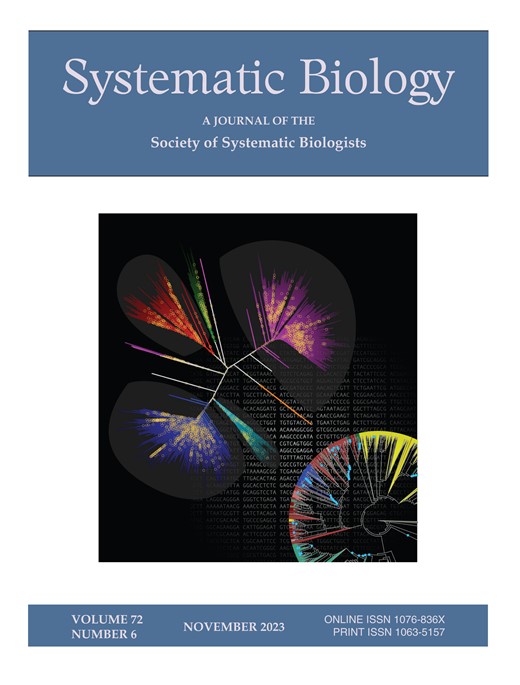多变量进化过程中的间断与渐进转变:对蜥蜴成对辐射的测试
IF 5.7
1区 生物学
Q1 EVOLUTIONARY BIOLOGY
引用次数: 0
摘要
随着谱系在时间上的分离,它们预计会积累突变(或发育-遗传)差异,即使在相似的环境条件下,这些差异也会影响这些谱系的宏观进化轨迹。在这里,我们比较了来自澳大利亚和马达加斯加的科学蜥蜴辐射的表型进化动力学,这两个物种相隔超过1亿年的独立进化,并显示出猖獗的表型平行性。我们从94个澳大利亚和29个马达加斯加物种的微ct扫描中收集了头骨、四肢和肢体腰带的线性测量数据。使用多元比较方法,我们测试了这种表面并行性的潜在进化协方差结构是否保守,以及这些模式在不同功能模块之间是否一致。马达加斯加和大多数澳大利亚石龙子有相似的头骨进化协方差矩阵。由于一些性状子集支持不同的进化过程,而对于其他子集,共享协方差矩阵不能被拒绝,因此四肢和肢体束的结果是模糊的。然而,在大多数特征集中,物种极其丰富的澳大利亚栉虎属(Australian genus Ctenotus)表现出与这些类群中所有其他蜥蜴(包括几个密切相关的属)截然不同的协方差结构。蜈蚣的变化表明,性状相关性的结构可以在相对较浅的时间尺度上发生变化,并可能解释该分支相对于来自两个地理区域的其他科学蜥蜴在形态空间上的独特位置。更一般地说,我们的结果表明,多元进化过程可以在相对较短的时间内发生巨大变化。本文章由计算机程序翻译,如有差异,请以英文原文为准。
Punctuated versus gradual shifts in the multivariate evolutionary process: a test with paired radiations of scincid lizards
As lineages become separated in time, they are expected to accumulate mutational (or developmental-genetic) differences that influence the macroevolutionary trajectories of those lineages even under similar environmental conditions. Here, we compare the dynamics of phenotypic evolution in radiations of scincid lizards from Australia and Madagascar that are separated by more than 100 million years of independent evolution and show rampant phenotypic parallelism. We collected linear measurements of the skull, limbs, and limb girdles from micro-CT scans of 94 Australian and 29 Malagasy species. Using multivariate comparative methods, we tested whether the underlying evolutionary covariance structure for this superficial parallelism was conserved and whether these patterns were consistent across distinct functional modules. Malagasy and most Australian skinks have similar covariance matrices for skull evolution. Results are ambiguous for limbs and limb girdles, as some trait subsets support different evolutionary processes and for other subsets, a shared covariance matrix could not be rejected. However, across most trait sets, the extremely speciose Australian genus Ctenotus exhibits a radically different covariance structure from all other lizards in these groups, including several closely related genera. The shift in Ctenotus demonstrates that the architecture of trait correlations can change at relatively shallow timescales and may explain the unique position of this clade in morphospace relative to other scincid lizards from both geographic regions. More generally, our results demonstrate that the multivariate evolutionary process can change dramatically in a relatively short period of time.
求助全文
通过发布文献求助,成功后即可免费获取论文全文。
去求助
来源期刊

Systematic Biology
生物-进化生物学
CiteScore
13.00
自引率
7.70%
发文量
70
审稿时长
6-12 weeks
期刊介绍:
Systematic Biology is the bimonthly journal of the Society of Systematic Biologists. Papers for the journal are original contributions to the theory, principles, and methods of systematics as well as phylogeny, evolution, morphology, biogeography, paleontology, genetics, and the classification of all living things. A Points of View section offers a forum for discussion, while book reviews and announcements of general interest are also featured.
 求助内容:
求助内容: 应助结果提醒方式:
应助结果提醒方式:


